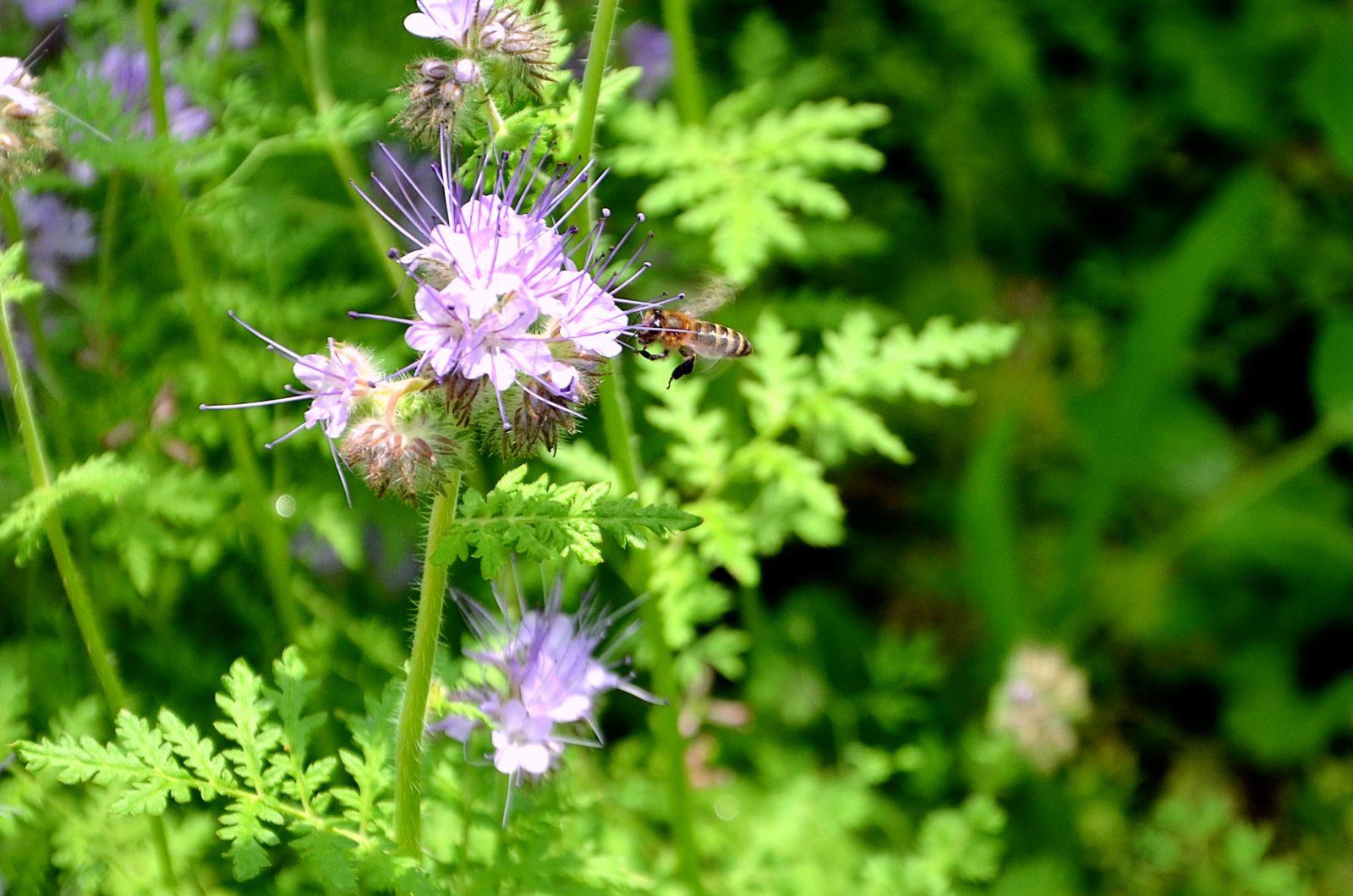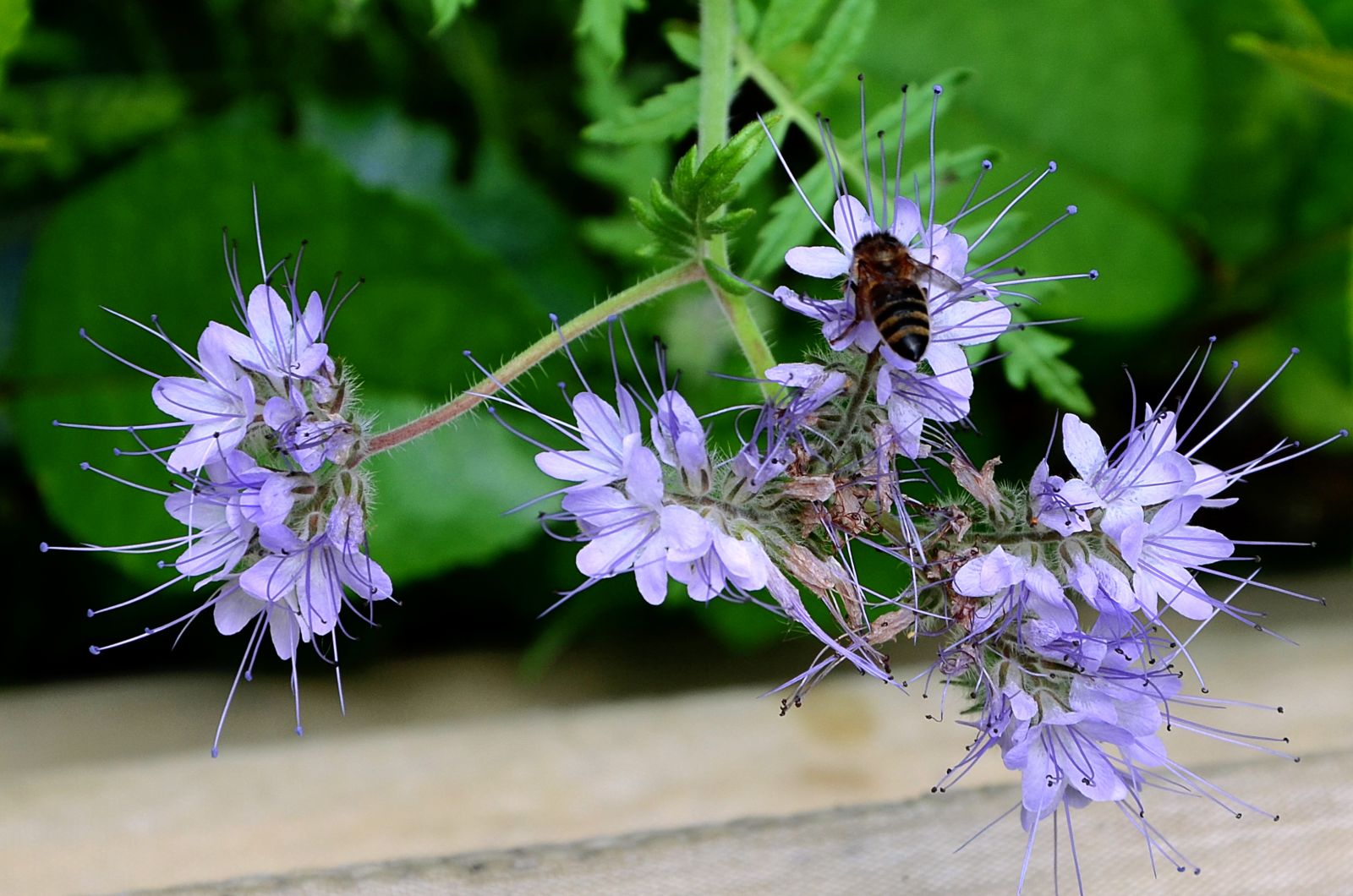A flower with an unusual melodious name is very popular among flower growers and farmers for its fragile beauty and incredibly valuable properties. The name of the flower comes from the Greek word for "bundle", which explains the arrangement of the florets in the inflorescence.
The flower originates from South and North America, but today phacelia grows and is cultivated in many other latitudes (Russia, Ukraine, China, India, Denmark and others), as well as there are wild specimens. The flower belongs to the genus of annual and perennial herbaceous plants from the family Borageaceae.

Смотреть фото в полном размере
Botanical Description
Phacelia grows from 0.3 to 1 meter high. The root of the plant has thin lateral sprouts and grows up to 20 cm deep. The reddish-colored stem also has lateral sprouts, which explains the resemblance of phacelia to a small bush.
Flowering takes place from late April to mid-autumn, the flowers open irregularly, some may bloom for only a couple of days. The type of inflorescence of the different phacelia varieties is bunch-shaped, when a large number of buds are gathered at the end of the stem in one dense bunch. There can be up to 100 buds on one stem at a time.
The flowers are shaped like bells and the color range varies from white to deep blue and purple. After pollination, the plant produces seed boxes with a very large number of seeds. Therefore, if the plant is not mowed, uncontrolled self-seeding of phacelia can begin. Phacelia species of Pyzhmalis are used as a natural fertilizer siderate.
Phacelia siderate and its properties
Phacelia is famous as a natural siderate that can be obtained independently in vegetable garden conditions, if you are experiencing a shortage of quality, organic fertilizers. Therefore, farmers are increasingly inclined to use phacelia siderate as a fertilizer. The principle of obtaining such a fertilizer is quite simple. The exhausted area is sown with a siderate and when the plant grows up, the stems with a peduncle should be mowed and let them simply rot. The mowed mass quickly rotting, forming the very nutritious humus, which fertilizes the soil, makes it fertile and saturated with all the necessary nutrients. After the formation of humus, the land is simply dug up and you have a fertile area ready for planting the chosen crop.
Most plants deplete the soil over time, taking all useful substances and minerals from it, but phacelia, on the contrary, saturates it. Only for 1.5 months, the plant can give 200-300 kg of nutritious humus, which is equal to 300 kg of manure.
Valuable properties of the crop:
-
fights weeds, shades plants;
-
tender leaves and buds quickly decompose, so the process of obtaining humus can be carried out several times a season;
-
nutrients penetrate well into the soil, saturating it;
-
protects the topsoil from erosion during rains and blowing away in strong winds;
-
protects plants from diseases and harmful insects;
-
loosens the soil by the roots, making it porous.
Siderates also include such crops as mustard and lupine. Each of these plants has its own characteristics and flowering peculiarities, so it is not recommended to plant them one by one. Any type of soil is suitable for phacelia, as it feels comfortable on any terrain.
Thanks to the beautiful blooms and such valuable properties of the plant, you can not only get a beautiful, lushly blooming garden, but also improve the quality of the soil on your property.

Смотреть фото в полном размере
Types and varieties of phacelia
The most popular species is Phacelia fiddlehead. It is no more than one meter tall and looks like a coniferous plant. One bush can produce about 20 shoots, leaves are 15 cm wide and about 20 cm long. The inflorescences are umbrella-shaped with 1 cm-sized florets of lilac color. The stamens are long and extend beyond the corolla.
If you decide to plant fiddle-leaved phacelia in your flowerbed, then for comfortable growth it suits acidic soil, but in general any other type of soil is suitable, even stony. Phacelia siderate has a beneficial effect on the soil, enriching it with potassium, nitrogen, nutrients, suppresses weeds and normalizes the pH level.
Phacelia is also renowned as an excellent mellifer, which is why it can be sown close to the hives so that bees can extract nectar from it later on. The honey from fiddlehead phacelia has a delicate taste and pleasant aroma.
Phacelia silvery is a fairly rare specimen growing in northern California on sandy soils. Reaches a height of half a meter. It has white inflorescences of round shape. It gets its name due to the white down on the leaves, which creates a silvery shimmering effect.
Phacelia bells is an unusually colorful plant with rich blue bell-like flowers. The stems are reddish in color, branching into many inflorescences, covered with a fine tuft. Low-growing plant with small toothed leaves up to 6 cm long. Tassel-shaped inflorescences fit perfectly into the landscape design, decorating garden beds, flower beds and park areas. This variety of plant is not transplanted, but immediately planted in the ground. Well tolerates frost and drought, is not demanding in care, improves the quality of the soil in which it grows. After flowering, it produces a large number of seeds for self-seeding.
Phacelia lancea is a variety up to 50 cm tall with bright green leaves and beautiful white, delicate lavender colored flowers with silvery flecks. The leaves are clearly visible with veins and silver flecks.
Phacelia twisted is a tall plant up to 50 cm with small blue flowers, which are gathered at the top of the stem. It blooms from early summer to fall, prefers a well-lit area, so it is suitable for landscaping gardens and park paths. Suitable for light soil, during periods of prolonged rainfall this variety slows its growth and the flowers lose their attractiveness.
The Pursha variety stands out for its unusual color and shape of petals. Buds with bright purple petals and white center. Buds sizes only up to 3 cm, blooms all summer, but when planting should choose low-wind areas, without draughts and without direct sunlight. It can be used to decorate flowerbeds or borders, especially when combined with other plant varieties.
Bolander's Phacelia likes shaded areas near large trees with a lush crown. Stem up to 90 cm long, large lavender-colored flowers. The green leaves are covered with small white tufts.
How to sow phacelia correctly
When and how to sow phacelia? A suitable time is the beginning of spring, when the air temperature reaches the mark of 9 degrees, because most varieties tolerate frosts well. Due to the fact that the flower quickly blooms and blooms, it can be sown 2-3 times a season, and on the most depleted soil as soon as the snow melts.
For seeding, you need:
-
For 1 cup of sand take 1 packet of seeds and mix well;
-
the seeds germinate well on their own even without stratification;
-
the resulting mixture should be planted on a site with sufficient sunlight;
-
sowing is done at a depth of 3 cm, the distance between seeds should be at least 30 cm;
-
Young seedlings require regular watering for the first 2-3 weeks;
-
Young shoots begin to bloom in about 1-1.5 months.
To avoid uncontrolled self-seeding, which can suppress other crops, you should periodically plow the plot before or during flowering of the siderate.
Benefits of phacelia
First of all, phacelia is an excellent remedy against weeds, improves the quality of the soil, since the flowers rot down quite quickly. Therefore, phacelia can be planted even in vegetable garden beds between seedlings with other crops, which will protect them from pests, weeds, temperature fluctuations and sunburn.
Mow the phacelia as soon as it has flowered and then simply mix it well with the soil. This will serve as a natural fertilizer and a natural source of nitrogen. The tender roots of the plant loosen the soil and make it porous, which improves air exchange.
If during spring-summer the plot is constantly sown with phacelia, then the overexcavated plot in the next 2-3 years will not need fertilizing with manure or other mineral fertilizers at all.
Flowers and stems of the plant are an excellent animal feed, which is widely used in agriculture. It serves as a worthy substitute for fodder mixtures, while it has many positive characteristics, useful properties and is suitable for any kind of animal. Farmers note that when animals are fed with phacelia, they are less sick, and young offspring grow faster.
But also phacelia is famous as a source of a useful and quite rare variety of honey.
Phacelia is a mellifer
Phacelia is one of the best honeybee plants. If you want to increase your yield, simply plant it near crops that require pollination. The fragrant lilac-colored buds attract bees with delicious nectar. Due to the fact that the flowers do not close even after sunset, the time for the bees to collect nectar increases. If the period of growth and flowering is properly calculated, it is possible to sow fields with phacelia 2-3 times from spring to fall, providing bees with nourishing nectar.
Phacelia-based honey with a slight tartness and a pleasant, subtle aroma, light color, sometimes with a greenish tint. It is often compared to linden honey. It is not subject to rapid crystallization, which is why it is valued by beekeepers who stock this honey as a winter bee food.
Useful and therapeutic properties of phacelia honey
-
helps with liver and stomach diseases;
-
acts as a dietary aid;
-
should be consumed if you suffer from heartburn, gastritis;
-
honey helps with stomach ailments, diarrhea;
-
beneficial effect on the mucous membrane of the stomach;
-
is used for heart disease;
-
improves memory and is therefore recommended for people with an intellectual profession;
-
It is recommended to take honey in the morning on an empty stomach, as well as before going to bed to relieve tension;
-
are used to treat the liver, as the glucose contained in honey saturates liver cells with glycogen;
-
Honey improves metabolism, increases the body's resistance, effectively helps with diseases of biliary and urolithiasis;
-
phacelia honey helps strengthen the immune system;
-
can serve as an antipyretic, antibacterial and analgesic;
-
By consuming honey regularly you will not only activate the brain, but also increase your performance.
| Total content and ratios of individual free amino acids | |
| Total content, mg % | 202 |
| Alanine | 1,7 |
| Valine | 4,3 |
| Leucine | 3,7 |
| Proline | 21,1 |
| Histidine + series | 0,4 |
| Threonine | 40,7 |
| Methionine | 4,7 |
| Phenylalanine | 3,7 |
| Glutamic acid | 4,2 |
| Glutamine | 0,3 |
| Lysine | 1,2 |
| Tyrosine | 1,6 |
| Asparagine | 0,4 |
| Mineral content in 100 g of honey (average data) | |
| Potassium | 36 |
| Calcium | 14 |
| Magnesium | 3 |
| Sodium | 10 |
| Sulphur | 1 |
| Phosphorus | 18 |
| Chrome | 0,3 |
| Chlorine | 19 |
| Iron | 800 |
| Iodine | 2 |
| Cobalt | 0,3 |
| Manganese | 34 |
| Copper | 59 |
| Fluorine | 100 |
| Zinc | 94 |
Contraindications
People suffering from diabetes are contraindicated with phacelia honey. Also if you have an intolerance to bee products honey should not be consumed. During pregnancy and lactation, it is recommended to consume honey in moderation or refuse it altogether, so as not to provoke an allergic reaction.
Honey is a powerful allergen that can provoke a reaction in the body, manifested as a rash, itching, swelling. In severe cases, honey can even cause Quincke's edema.
Phacelia care
The plant does not need special care, and therefore even a novice gardener can cope with the cultivation of this species. Here are the basic requirements for favorable growth of phacelia.
-
Watering of the siderate is done in the first weeks, until the moment of germination of seedlings. Therefore, rainwatering is quite enough for the plant. Watering the soil is necessary only in the period of prolonged drought. Т
-
Loosening the soil improves air exchange in the soil and also prevents uncontrolled self-seeding.
-
If you are growing ornamental varieties, they will need organic supplements or fertilizers with phosphorus, boron or magnesium.
-
If the soil is sufficiently saturated with nutrients, the honeybee does not need additives.
-
It is necessary to get rid of weeds in the first 2-3 weeks after the phacelia starts to grow. Then the plant will start to fight weeds on its own, protecting the plot.
-
Mow phacelia as early as possible, so that the stems and buds do not have time to coarsen, otherwise the process of decomposition will take longer. The main advantage of phacelia is its fast decomposition.
As you can see, at first glance, an ordinary, fragile flower has an invaluable store of useful properties. Therefore, try to sow phacelia on your plot to enjoy its exuberant bright blooming in summer and to give bees a source of nectar for obtaining therapeutic honey.
A few interesting facts about phacelia
-
Beeeekeeping: Phacelia is one of the most valuable honey plants. It produces abundant amounts of nectar which attracts bees. Honey obtained from phacelia nectar has a pleasant aroma and taste.
-
Siderate: Phacelia is often used as a siderate, i.e. green fertilizer. It grows quickly, forms a dense green mass, which after plowing improves the soil structure and enriches it with nitrogen.
-
Beautiful Flowers: Phacelia is known for its beautiful and graceful flowers. The flowers are usually blue or purple in color and are gathered in twisted clusters.
-
Drought tolerance: Phacelia is quite drought tolerant, making it an excellent choice for dry and hot climates.
-
Diversity of species: There are various species of phacelia, including perennial and annual species. Some species are used for ornamental purposes, others for agriculture, and some species are considered rare and red-listed.
-
Name origin: The name "phacelia" comes from the Latin word "facies", which means "face". This is due to the shape of the flower, which resembles a face.
Article prepared for UFL - order flowers with delivery in Kiev in 1 hour.

